A visitor’s observations on the National Museum of African American History and Culture, Part I
30 May 2017 – Will Walker
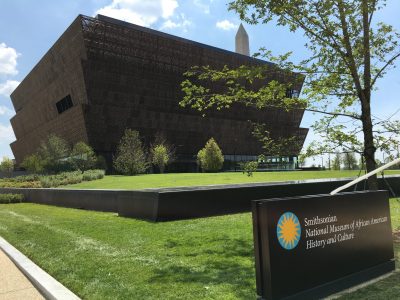
National Museum of African American History and Culture. Photo credit: Fuzheado, Wikimedia Commons.
The first time I tried to visit the National Museum of African American History and Culture, my friends and I got only as far as the grassy area on the Constitution Ave. side of the building. Less than a month after the museum’s grand opening in September 2016, the feeling around the David Adjaye-designed masterpiece that Sunday was electric. Vendors were selling t-shirts, food trucks were lined up along the sidewalk, and many people had come to the museum’s grounds just to hang out even if, like me, they did not have tickets. Although I had spent a good amount of time over the past decade and a half at the Smithsonian, it was the first time I truly felt that DC’s image as “Chocolate City” was reflected in the people on the Mall. The crowd overall was diverse and multicultural, but there was a decided plurality of black people—clearly drawn to this place because of the museum. Even a few years earlier, many of these folks would not have chosen to stroll around the Smithsonian on a Sunday afternoon. It was the new museum that had attracted them to be part of the scene that day—the simple fact of its presence transformed the space of the National Mall, making it a Mecca for all kinds of people.
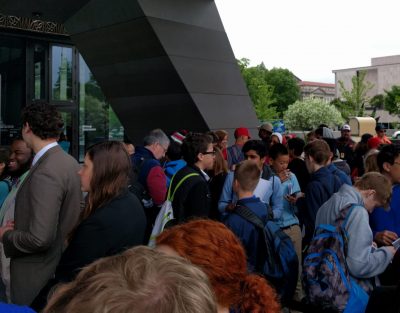
School group lines, NMAAHC. Photo credit: Will Walker.
The next time I visited six months later, it was with a ticket in my hand. I stood outside with a group of graduate students anxiously waiting to see the museum I had heard so much about. The crowd lined up to enter that morning was different from the crowd on that first Sunday. It was still diverse, but the overall composition was whiter, at least among the school groups that surrounded us. It was April, field trip season in DC, and these were the lucky kids whose teachers or chaperones had managed to secure coveted tickets.
As we waited in the group area, I couldn’t help but stare at several white young men at the front of one of the lines wearing red “Make America Great Again” caps. I wondered if this fashion choice was a deliberate provocation, knowing that many visitors to the museum might not share their political preference and perhaps even see it as a conscious assertion of white pride. At the same time, I thought that it might simply reflect their desire to jump on the current political bandwagon or to engage in a form of teenage rebellion. On a deeper level, I wondered how visiting the museum might influence their perspectives on U.S. society and politics as well as their own racial identities. Indeed, this was a question I had of all my fellow visitors.
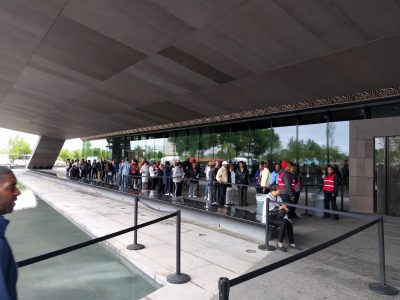
General visitation line for the National Museum of African American History and Culture. Photo credit: Will Walker.
The crowd on the general visitation line was more evenly mixed than the school group lines—more reflective of the crowd I had seen on my first visit. Here were black folks and others whose excitement at seeing the museum was clearly visible as they waited their turn to pass through the security screening at the entryway. As with me, their visits seemed to carry the weight of a pilgrimage, a journey to both pay respect and discover things about one’s self.
As the museum’s opening hour of 10:00 a.m. arrived, both school groups and general visitors made their way through a lengthy, but well managed, process of entering the museum. Once in the main atrium, my fellow visitors and I were directed downstairs to another line for the main history exhibition. The mood of the visitors around me was positive overall and I only detected minor confusion as we were shepherded to the starting point of our journey through five centuries of African American history. Given the large crowds, a healthy dose of patience is definitely a requirement for visitors; however, very few seemed to be complaining—rather there was ample good feeling in the air.
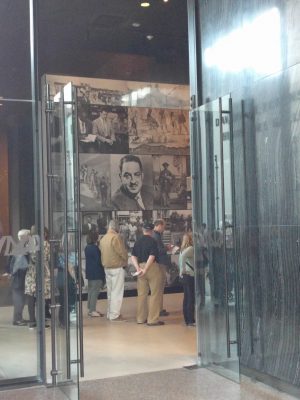
On line for the history exhibition. Photo credit: Will Walker.
After a wait of no more than ten minutes, the elevator took us down three levels to the beginning of the history exhibition. Our group entered a narrow space with long cases filled with objects and concise, well-written labels. Although we were a bit cramped in this initial area, people waited politely to see as much as they could. The introductory label to the first section—“Slavery and Freedom, 1400-1877”—nicely explained not only the gallery’s focus, but the larger frame of the museum:
Five hundred years ago, a new form of slavery transformed Africa, Europe, and the Americas. For the first time, people saw other human beings as commodities—things to be bought, sold, and exploited to make enormous profits. This system changed the world.
The United States was created in this context, forged by slavery, as well as a radical new concept, freedom. This is a shared story, a shared past, told through the lives of African Americans who helped form the nation.
Here, in only 81 words, was a synthesis of decades of scholarship, as well as a kind of mission statement for the museum. Having followed the museum’s development closely, I understood that the framing of African American history as American history was a key objective of the overall project. It was a laudable goal in and of itself, and yet, as I progressed through the exhibits, I also saw the museum diving deep into critical histories of race, slavery, capitalism, and culture.
On this same introductory label was a quotation—“We’ve got to tell the unvarnished truth”—from John Hope Franklin, one of the great pioneers of African American history and an advisor to the museum. This statement serves as an unofficial motto for the museum’s history exhibitions, and as my fellow visitors and I began our journey through the exhibit halls, those who knew Franklin’s work could easily see his spirit imbued throughout—even though he passed away in 2009 when the museum was only about halfway through its process of development. A fitting tribute to Franklin, this is a history museum of the highest order—a monumental project steeped in deep research and the telling of narratives embedded within larger social, cultural, economic, and political structures.
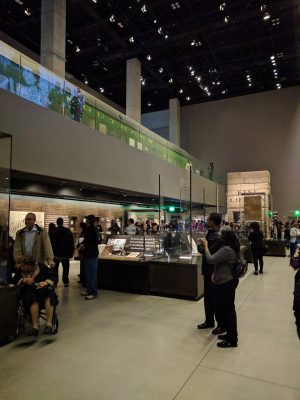
Main history exhibition, NMAAHC. Photo credit: Will Walker.
As a public historian, the museum’s overarching approach to presenting African American history and culture was apparent to me, but I found myself wondering as I progressed how other visitors were understanding it. Examples of visitors engaging with the museum’s content were abundant; everyone seemed to be looking closely at something. The museum offers a feast of compelling visuals and objects. Looking around, I imagined what my fellow visitors, most of whom presumably were not professional historians, were garnering from the experience. Were they discovering the enormity of African American history and finding black people playing critical roles throughout American history? Were they absorbing implicit and explicit critiques of American society? Were they recognizing the intertwined histories of slavery, race, and capitalism? Were they finding things to celebrate as well as lament? My unscientific answer to these questions was, for the most part, “Yes.” (Continued in Part II)
~ Will Walker is associate professor of history at the Cooperstown Graduate Program (SUNY Oneonta). He is a lead editor of History@Work and author of A Living Exhibition: The Smithsonian and the Transformation of the Universal Museum.




I appreciated reading about your discoveries and experience visiting the NMAAHC. I’ve been twice now and I have to say that I find this wonderful museum is going to take me multiple times to take it all in. Having one museum to see the extent of my heritage is so over overwhelming. I have so many emotions and thoughts such as – what would my ancestors say about me living free in America? and “how many visitors to the museum are looking at relatives in the unnamed photographs of slaves that they don’t know are related to them?” Then there are deeper questions like “would my ancestors have believed it would have taken several hundred years to be where we are now?” And will my daughters’ experience a better or worse America than the one I grew up in? I look forward to going back with my wife and daughters many times to experience this museum in the future.
Thank you so much for sharing your responses to NMAAHC. I also felt like it would take multiple visits to truly absorb everything and I’d like to return for another visit soon. Have you been able to share your reflections with anyone at the museum yet? I wonder if they have been able to gather responses like yours. It would be wonderful to have them preserved.
Dr. Walker,
Thanks for putting your thoughts in writing. So often I find museums overwhelming as they try and tell a complete story. The new museum at the Gettysburg’s Visitors Center is an example. Wonderful but overwhelming. Did you find the MNAAHC digestible in one visit?
It is overwhelming, but it needed to be. It will definitely take multiple visits to see everything, but that’s okay. When I visit a big museum like this, I like to focus in on a few things and really spend time with them, rather than try to see everything.